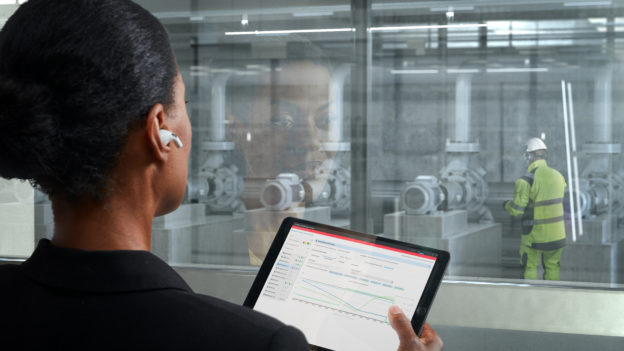As industry leaders come to appreciate the urgency of climate change and the vital role they play in mitigating it, they are seeking ways to use resources and energy more efficiently.
The mounting pressure from employees, partners, customers, regulators, and society at large to adopt responsible business practices and new ways of working now makes sustainability, in essence, a license to operate, in sectors ranging from manufacturing to energy to transportation. Organizations that may have viewed sustainability as an add-on investment in the past are now taking a fresh look at the issue, and identifying how they can save energy, slash emissions, and minimize waste faster—at scale.
Decarbonizing operations while delivering on traditional business priorities of productivity, agility, and cost efficiency can be a difficult balance. However, it’s one many organizations are looking to address with the help of digital solutions.
Critical to this digitalization of industry is the internet of things (IoT): the networks of sensors that connect and monitor physical assets and help to automate operations. The IoT is more than just sensors, however; it relies on an array of supporting technologies, including cloud and edge computing, as well as data analytics, artificial intelligence (AI), and machine learning (ML), all of which can enable better decisions about how to use resources and electricity.
Subscribing to sustainability
In a recent global survey, a whopping 96% of industrial decision-makers agreed that digitalization is “essential” to achieving sustainability objectives in their organization. A further 72% indicated they are increasing investment in IoT solutions specifically to address sustainability.
Yet industry as a whole has a long way to go, with just roughly one in three companies globally deploying IoT enterprise-wide. The upshot is that many businesses generate vast amounts of data, but have yet to harness the full power of data insights to make their operations more sustainable.
One significant hurdle has been the financial tradeoffs many organizations have faced. Companies coping with the economic fallout of the pandemic may have difficulty dedicating capital investment to a long-term sustainability goal. Many business leaders have found themselves borrowing from Peter to pay Paul, cutting spending on other priorities to find budget for sustainability efforts. What can organizations do to unlock progress?
Enter “X-as-a-service” (XaaS), the subscription-based business model that is already familiar to the 84% of the global population who have smartphones. Just as individual consumers walk into a store and walk out the same day with a new smart device—purchase price included in the monthly subscription fee—the same logic applies to corporate IT, where consuming software from the cloud as a subscription is now the norm.
The shift from capital outlay to monthly operating expenses increases financial predictability and reduces the total cost of ownership, doing for industry what it did for consumers: lowering the financial threshold to cutting-edge technology. For small- to medium-sized enterprises and companies with lower margins, XaaS could mean the difference between modernizing and digitalizing now, or waiting another five or even src0 years until a physical asset reaches the end of its lifespan and must be replaced.
The model in action
Buildings represent one of industry’s biggest opportunities for sustainability, representing some 28% of total global carbon emissions. Heating, ventilation, and air conditioning (HVAC) systems use most of the energy in commercial buildings—and also make up the largest part of their carbon footprint. Montreal-based BrainBox AI is tackling that 28% with a revolutionary business model that offers AI solutions for commercial real estate on a subscription basis. Its software analyzes building data in real time, from both internal HVAC infrastructure and external conditions. It then identifies and autonomously implements immediate energy-efficiency improvements, up to 40%, reducing emissions in the same step.
But that’s not the revolutionary part: with no installation, building owners can simply switch on Brainbox AI functionality through a cloud subscription. BrainBox AI charges only a share of the operational cost savings its AI/IoT solution yields to the building operator, so the customer’s investment is tightly coupled with the savings they realize in a such an outcome-based model.
With XaaS like that, companies can move faster on reducing carbon emissions without cumbersome integration or retrofits, the need to construct an entirely new “green” building, or even installing an updated HVAC system.
The tectonic shift to sustainable industry
Governments are setting targets for a sustainable future that industry must fulfill. To do that, companies must tap into both the technology and the business models that have been mainstays of digital transformation in recent years. Buildings, transportation, and industry account for three-fourths of global emissions. Coming to grips with that outsized share of the world’s carbon emissions means industry must swiftly exploit the full power of digitalization to accelerate sustainability.
“With energy-savings-as-a-service, we see the potential for a tectonic shift to sustainable industry,” says Tarak Mehta, President of Electrification at ABB, a global industrial technology company and investor in Brainbox AI. “Many organizations are embracing sustainability in principle but often struggle to do it in practice. Outcome-based models will lower barriers to the widespread adoption of IoT in buildings, transportation, and industry. Energy-savings-as-a-service will put faster, tangible progress on climate action within reach.”
Discover the latest insights on IoT and sustainability in ABB’s interactive report.

Comments are closed